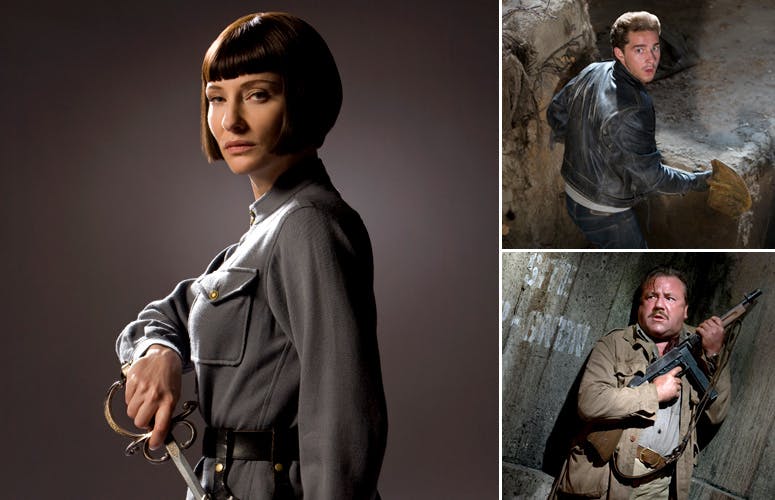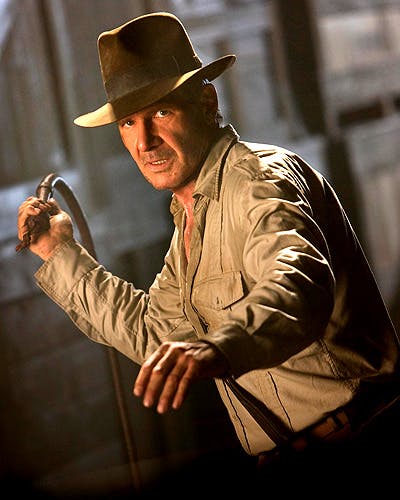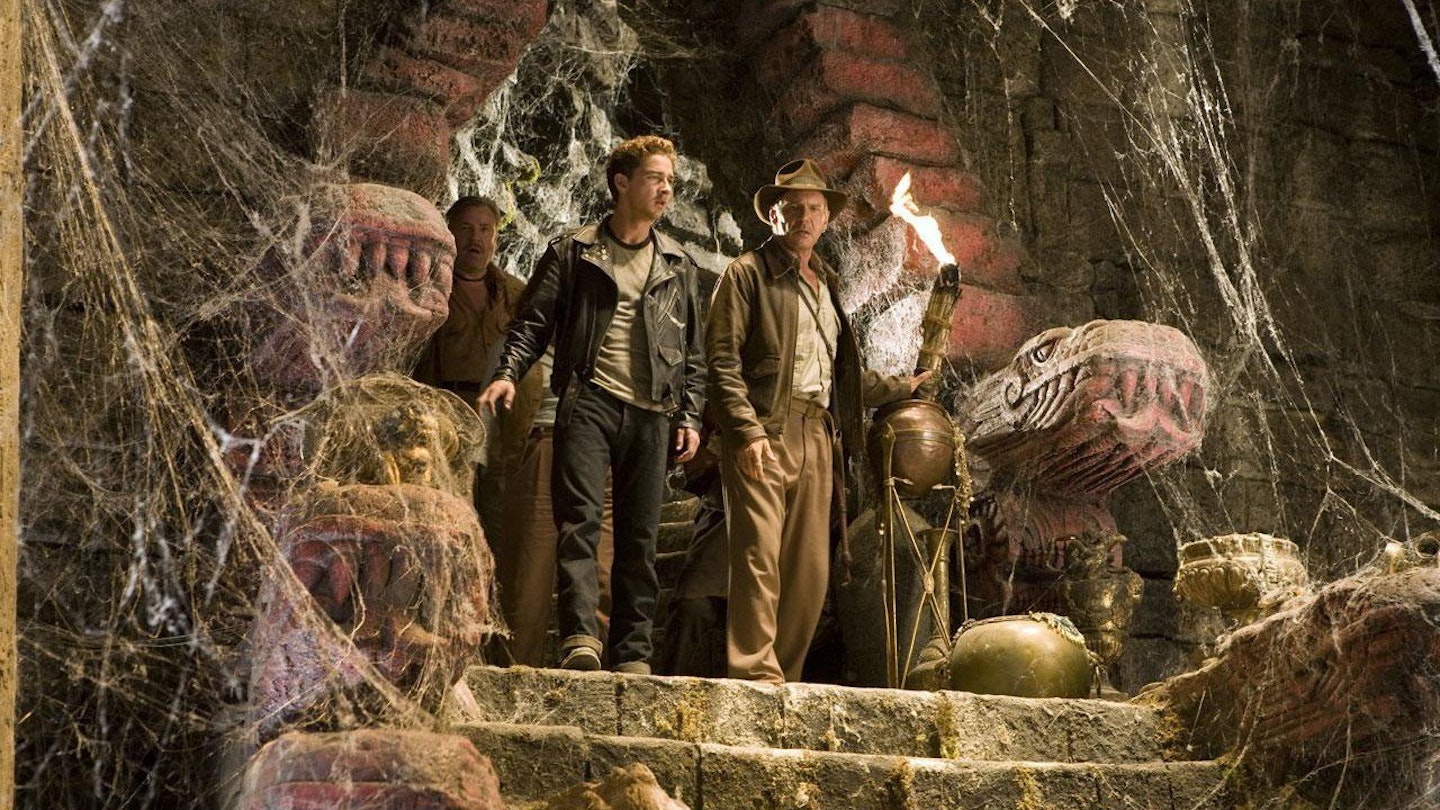Words from this article first appeared in issue 208 of Empire magazine. Subscribe to Empire today{

"This ain't gonna be easy..."
Steven Spielberg (Director): Harrison called me and said, "Why don't we make another one of these pictures? There's a fan base out there that wants it. He was tenacious. He called George and George got to thinking about it, and then George called me and said, "Well Steve, what do you want to do? It could be fun to make another movie."
Harrison Ford (Indiana Jones): Every once in a while a script would show up and it wouldn't be exactly what we hoped for one or the other of us. It took us all a long time to get on the same page. Or 120 pages. I think it was worth the wait. We've ended up with something we're all happy with. That was the way to go to work.
George Lucas (Executive Producer): The supernatural part has to be real. Which is why they're very hard, and you run out [of options] very fast. You have to have a supernatural object that people actually believe in. People believe that there was an Ark of the Covenant, and it has these powers. Same thing with the Sankara stones, same thing with the Holy Grail.
Frank Marshall (Producer): The Crystal Skulls are something that people have been interested in for a long time. There's thirteen of them around the world now and are believed to have magical or healing properties or being full of the entire knowledge of the Universe. It's about power. If you look at the Ark of the Covenant - people get power hungry. That's what the journey is here - everyone is after this source of power.
Ford: The mysterio-crypto elements are not really my bag. I like the relationship elements, the adventure elements. George feels that the 'ooh-ey ooh-ey' stuff is a strong string in our bow. I admit he's right. He's always right. More or less.
Spielberg: All the traditions of Indiana Jones are back again. We've got the map; we've got the plane and the vehicles with the little red line showing you how you're hop-scotching across the globe - and it's just part of the milieu that we've spent many years establishing.
Kathleen Kennedy (Executive Producer): It's always interesting when you look at a trilogy and the first, second and third movie is almost like the first, second and third act. It happened with Star Wars, it happened with Back To The Future. The second movie is often a dark movie because that is where the conflict occurs and the third movie is often upbeat for the resolution. The three movies very much travel in that vein. Doing the fourth movie, this many years later, I think there's a sense to repeat some of the overall feelings of those three movies in one film. I think people will feel that way.
Kennedy: With Bond being the inspiration behind the whole series to begin with, it was just a great way to pull that all together.
Spielberg: Crystal Skull follows the same sine wave pattern as the first three films. There is the characteristic teaser that is the third act of a film we never got to see; then the MacGuffin is introduced, there is that long but I hope not boring explanation of what the MacGuffin is and what its potential powers are. Then the adventure gets out of the gate and just goes racing down the track.
Age Concerns
Lucas: There was never any question about the fact that we were going to have Harrison play his age.
Spielberg: There's a line that was thematic for me, and it's not a line that's actually in the movie. And it illustrates why I was comfortable letting Harrison age 18, 19 years. In the first movie, he says, ''It's not the years, sweetheart, it's the mileage.'' Well, my whole theme in this movie is, It's not the mileage sweetheart, it's the years. When a guy gets to be that age and he still packs the same punch, and he still runs just as fast and climbs just as high, he's gonna be breathing a little heavier at the end of the set piece. And I felt let's have some fun with that. Let's not hide that.
Kennedy: The fifties were an interesting period, because it was still an age of innocence, a time when we were coming out of World War II and people were exciting about moving into the future.
Spielberg: It was important for me that the character move into The Atomic Age. Our film takes place in 1957 which is totally informed by the Cold War, by McCarthyism, by hot rods, and girls wearing letter sweaters, ponytails and saddle shoes. For me, the '50s were emblematic of music, of the very beginning of rock and roll. It was Technicolor. The Fifties means the bright young faces that Norman Rockwell loved to paint.
%20*Cate%20Blanchett%20as%20Irina%20Spalko%20(left),%20Shia%20LaBoeuf%20as%20Mutt%20Williams%20(top%20right)%20and%20Ray%20Winstone%20as%20'Mac'%20George%20Michale%20(bottom%20right?auto=format&w=1440&q=80)
The Baddies
Lucas: If you're going to make a movie about the 1930s, it's almost impossible to do it without the Nazis. And it's the same thing when we got to the '50s here. We have to deal with the Russians because that's where we were. It's not like we set out to make a film about Russians. It was more about what was going on in the world. What were the issues? Who was doing what?
Spielberg: Setting the story in 1957 planted us firmly in the middle of the cold war with the threat of nuclear annihilation and The Red Menace, as it used to be known in America. Those were the things that were in the headlines on a daily basis, so when it came to who the villains would be, the Russians got the job.
Cate Blanchett (Irina Spalko): Spalko has an almost impenetrable steel-like quality to her - not a hair out of place, whatever she's doing, never anything on her boots whatever mud she's walking through. There's a remarkable precision about her. She's penetrating and, therefore, potentially lethal.
Spielberg: Cate scared me at times. Cate really took over the full interpretation of Irina Spalko and this went right to the costume, the hair and the make-up. Cate was the one who made all of those decisions.
Ford: Spalko's properly bad. It was wonderful to work with Cate Blanchett, she's a wonderful actress. She's a very easy person to work with. She doesn't exactly stay in character but I had not seen her out of that wig and costume till about the third week. When she wandered on the set, I didn't know who she was. She made a great foe.
The Sidekick
Spielberg: Everyone one of these movies has a sidekick and Shia is the sidekick in this one. He really holds his own when he's given the opportunity, fighting side by side with Indiana Jones. There's one point in the movie I wasn't sure who I wanted to look at more. I was going from Harrison to Shia, Harrison to Shia. Oh my God, they're sharing the scene equally that's amazing.
Shia LeBoeuf (Mutt): I watched a lot of movies to prepare to play Mutt. I watched a movie called Blackboard Jungle a lot, and I watched The Wild One all the time. And those two movies were on repeat. I would steal mannerisms, steal words - basically that was what my research was, just theft! I mean, the closest picture you can get of the time is in film, and so Steven would bring these DVDs in for homework. "Go watch this and find something."
Lucas: Shia got sent to the American Graffiti school of greaserland. And I became the consultant on his comb.
LeBoeuf: I'd bring a switchblade to set and say, "Hey Steven, what do you think of this?" And before I had come to set, I had worked on it for like a month and a half, flipping it and being able to mess around with it in a cool way. I'd film myself and bring the DVD to show Steven and he'd say, "Yeah, that's awesome." So then we'd implement it. It's amazing how much freedom he does allow, you know. It's pretty incredible.
%20%20*%22The%20mysterio-crypto%20elements%20are%20not%20really%20my%20bag.%20I%20like%20the%20relationship%20elements,%20the%20adventure%20elements.%22*%20*Harrison%20Ford*%20%20
LeBoeuf: I have great memories of Karen when she first came on the set. She and Harrison met for the first time in over twenty years for the make-up and hair tests we did before we ever started shooting the movie - everybody on the set had tears in their eyes. People were walking off into corners, some of them not wanting to show their emotions. It was something to be experienced.
Karen Allen (Marion Ravenwood): It was so amazing. We kinda just threw ourselves into each other's arms. The very first scene we were shooting was actually a funny, quite difficult scene that required some sort physical thrusting of our bodies, we were both bumping into things and getting little bruises and I just found myself looking at Harrison and saying, you know, this is fantastic, I am so delighted to be working with you again.
Thrills And Spills
Ford: We did all the action stuff in the old school way. The big difference this time round was they figured out ways how to safety us. "Shia and I had a flying suit, a custom built harness where we could attach a wire so if something went wrong, we would have a safety net. For the warehouse leap, my hands are holding on but I'm safetied by a wire they take out digitally. They never used to do that.
Rau Winstone (Mac): Harrison drives the jeep better than the stunt man and we've got good stuntmen on this film. We obviously did some dangerous shit but the stunt boys have to do it because of insurance and because we're cowards.
Blanchett: We were doing a chase sequence through the jungle in Hawaii and all of a sudden, he wanted us to introduce a karate-chop sequence, so we had to get that together very quickly. It's a great way to work actually, because it means that everything you do is really fueled and focused by adrenaline.
Marshall: We tried to keep it in the style of the first three movies, so there's not a lot of wild camera moves, even though you can have the helicopter cam and the spider cam and all those things. We kept it within the tradition of the Indiana Jones movies. That was a rule that Steven set right off the bat and everybody worked within that. A lot of the time, it makes people more inventive.
Spielberg: We had the requisite snake, a beautiful giant snake to us, but not to Indy, of course. It was a rather large python. The audience wouldn't forgive us if we didn't have at least at one snake in the movie.
Back Of The Net
Marshall: In today's information age, secrecy has been a real challenge. Someone stole some of the proof sheets of the photos and, when he tried to sell them online, a Webmaster alerted us. We set up a sting and the guy was arrested. It was really great. People actually said 'No, we're going to respect Steven's vision'.
Lucas: Y'know, Steven will say, ''Oh, everything's out on the Internet - what this is and what that is.'' And to that I say, ''Steven, it doesn't make any difference!'' Look - Jaws was a novel before it was a movie, and anybody could see how it ended. Didn't matter.
Spielberg: But there's lots and lots of people who don't want to find out what happens. They want that to happen on the 22nd of May. They want to find out in a dark theater. They don't wanna find out by reading a blog.... A movie is experiential. A movie happens in a way that has always been cathartic, the personal, human catharsis of an audience in Holy Communion with an experience up on the screen. That's why I'm in the middle of this magic, and I always will be.
Head back to our Indy hub for more exclusive features and interviews celebrating all four Indiana Jones movies.
 ![] Empire Magazine
![] Empire Magazine
For the best movie coverage every month, make sure you subscribe to Empire magazine - also available to download on iPad.


